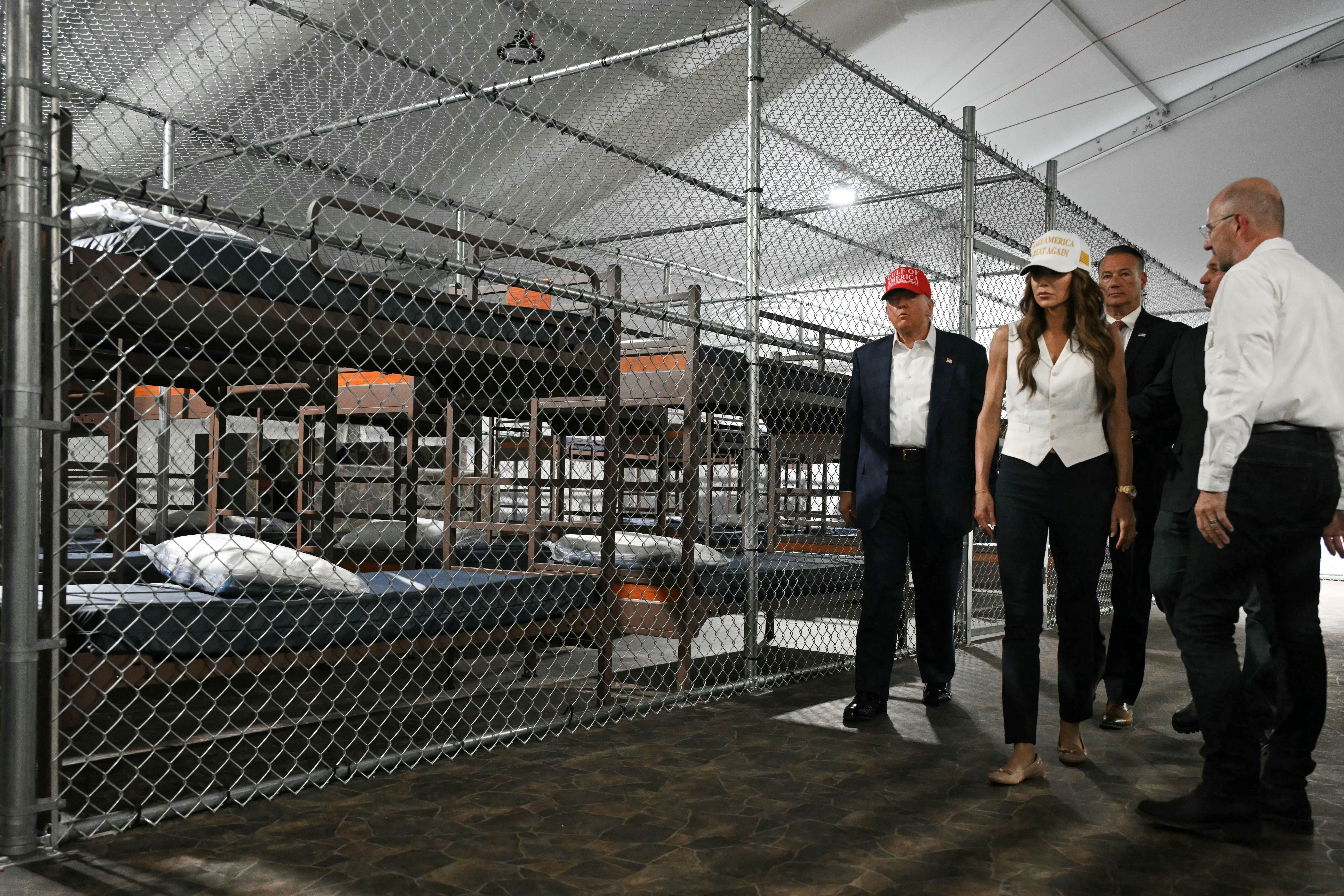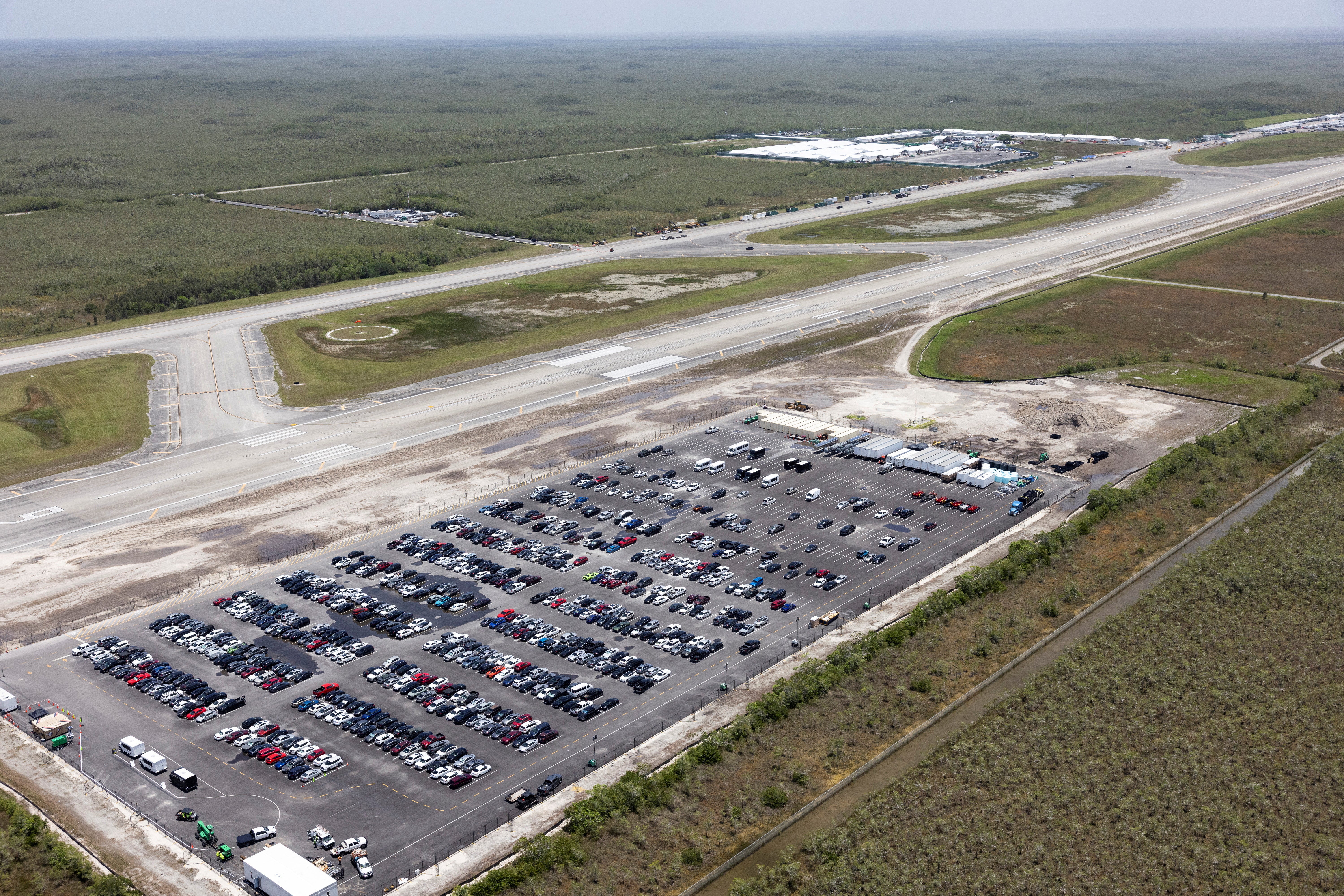Homeland Security Secretary Kristi Noem envisions more “Alligator Alcatraz”-like immigration detention centers across the country, including near airport runways, to boost the “efficiency” of Donald Trump’s mass deportation agenda.
The Florida facility is serving as a model for state-run detention centers, and “the locations we’re looking at are right by airport runways that will help give us an efficiency that we’ve never had before,” Noem told CBS News.
Noem told the network she has appealed directly to state officials, and “most of them are interested.”
She added: “Many of them have facilities that may be empty or underutilized.”
The administration has reportedly sought out facilities in Arizona, Nebraska and Louisiana, which currently houses the only Immigration and Customs Enforcement detention center on a tarmac. The Alexandria Staging Facility sits across from the Alexandria International Airport, which has emerged as the nation’s deportation capital under the Trump administration.
For more than a decade, ICE — which operates under Homeland Security — has turned to corporate shipping and logistics companies for inspiration for rounding up and deporting immigrants. Shortly after he was tapped to lead the agency in March, ICE’s acting director, Todd Lyons, bluntly compared the movement of people to packages.

“We need to get better at treating this like a business, where this mass deportation operation is something like you would see and say, like, Amazon trying to get your Prime delivery within 24 hours,” Lyons told a law enforcement conference in Phoenix in April.
“So, trying to figure out how to do that with human beings,” he said.
Lyons later expanded on his remarks about treating immigrants like packages in an interview with Boston 25 News that same month.
“The key part that got left out of that statement was, I said, they deal with boxes, we deal with human beings, which is totally different,” he said.
ICE “should be run like a corporation,” he told the outlet.

“We need to be better about removing those individuals who have been lawfully ordered out of the country in a safe, efficient manner,” Lyons continued. “We can’t trade innovation and efficiency for how we treat the people in our custody.”
In a statement to The Independent, Homeland Security assistant secretary Tricia McLaughlin said the agency is “working at turbo speed on cost-effective and innovative ways to deliver on the American people’s mandate for mass deportations of criminal illegal aliens.”
“With the opening of Alligator Alcatraz, we expanded facilities and bed space in just days,” she added. “We look forward to partnering with other states to open other similar facilities to house some the worst of the worst criminal illegal aliens.”
Named Alligator Alcatraz by state and federal officials, a 3,000-bed detention center opened in south Florida last month within the Dade-Collier Training and Transition Airport, roughly 43 miles from Miami in the middle of the Everglades.
A federal lawsuit accuses the facility of blocking detainees from legal counsel and forcing people into “overcrowded, unsanitary, and harsh conditions” with inadequate food, flood-prone cells, and “excessive use of force” from guards that sent at least one man to a hospital.

It’s also unclear who is actually running the facility and who wants to take responsibility for it. Government lawyers could not immediately answer in court whether the federal government or Florida is responsible.
In court filings, immigration officials claimed that the facility is operating through the federal 287(g) program, which allows local and state law enforcement agencies to enforce federal immigration law. ICE has inked nearly 800 such agreements covering 40 states.
“We need to get to the bottom of the interplay between the federal and state authorities on who’s running this thing,” Florida District Judge Rodolfo A. Ruiz II said during a recent court hearing in a lawsuit against the facility.
The makeshift facility is expected to cost roughly $450 million within its first year, at roughly $245 per inmate bed per night, according to DHS. ICE spent roughly $187 per adult detainee per day in 2023.
Still, Noem claims that the Alligator Alcatraz model is “much better” than ICE’s current arrangement with local jails and for-profit prison companies, which operate a vast majority of the nation’s detention centers.
Funding for Alligator Alcatraz largely comes from FEMA’s Shelter and Services Program.
The incoming wave of state-run detention centers is expected to tap into $45 billion in new funding for ICE as part of Trump’s “big, beautiful bill.” The bill also allocates $30 billion for an aggressive recruitment campaign to hire another 10,000 ICE agents.
Altogether, the bill earmarks more than $170 billion for immigration enforcement — a boon to for-profit contractors and cash-strapped states looking to tap into billions of taxpayer dollars.
Putting those new facilities near airports and runways will help ICE cut costs by “facilitating quick turnarounds,” Noem told CBS.
“They’re all strategically designed to make sure that people are in beds for less days,” Noem said. “It can be much more efficient once they get their hearings, due process, paperwork.”



.jpg?trim=0,1,0,0&width=1200&height=800&crop=1200:800)